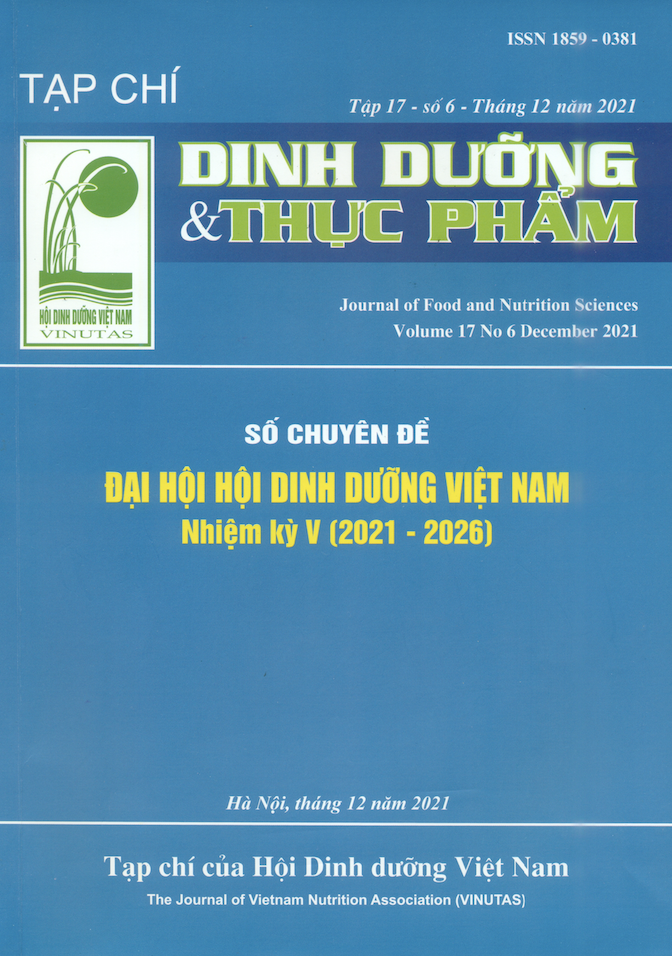CHẾ ĐỘ ĂN GIẢM MUỐI ĐỂ NÂNG CAO SỨC KHỎE TIM MẠCH VÀ KIỂM SOÁT TĂNG HUYẾT ÁP
Nội dung chính của bài viết
Tóm tắt
Muối ăn (NaCl) là một gia vị kích thích vị giác, mang lại vị mặn và giúp món ăn trở nên ngon miệng. Tuy nhiên, việc tiêu thụ quá nhiều muối liên quan chặt chẽ tới sự phát triển của một số bệnh mãn tính không lây nhiễm. Để hạn chế lượng muối ăn vào, Bộ Y tế Việt Nam đã đề ra mục tiêu đến năm 2025 sẽ giảm 30% mức tiêu thụ muối trung bình/người/ ngày ở người trưởng thành. Có nhiều phương pháp giảm tiêu thụ muối hay giảm lượng natri ăn vào như chủ động giảm lượng muối ăn vào từ thực phẩm và gia vị, sử dụng một số thành phần thay thế muối như kali clorua, canxi clorua, magie clorua… và đặc biệt, gần đây, việc áp dụng kỹ thuật sử dụng thành phần tạo vị để duy trì vị ngon cho thực phẩm giảm muối được các nhà khoa học quan tâm. Trong lĩnh vực này, ứng dụng khả năng tạo vị umami của axit amin glutamate dưới dạng mononatri glutamate (bột ngọt / mì chính) để thay thế một phần muối ăn là một phương pháp đang được nhiều quốc gia trên thế giới áp dụng hiệu quả.
Từ khóa
Axit amin, glutamate, mononatri glutamate (MSG), giảm muối, tăng huyết áp, duy trì vị ngon
Chi tiết bài viết
Tài liệu tham khảo
2. Gillette, (1985). Strategies to Reduce Sodium Intake in the United States.
3. Djin Gie Liem et al., (2011). Reducing Sodium in Foods: The Effect on Flavor. Nutrients. 2011, 3, 694-711
4. Rafaele Campo et al., (2020). Less Salt, Same Taste: Food Marketing Strategies via Healthier products. Sustainability, 12, 3916.
5. Karanja N. et al., (2007). Acceptability of Sodium-Reduced Research Di ets, Including the Dietary Approach es to Stop Hypertension Diet, among Adults with Prehypertension and Stage 1 Hypertension. J Am Diet As- soc., 107(9), pp. 1530-8
6. Rysová, J., & Šmídová, Z., (2021). Effect of Salt Content Reduction on Food Processing Technology. Foods (Basel, Switzerland), 10(9), 2237
7. Nelson G., Chandrashekar J., Hoon M., Feng L., Zhao G., Ryba N., et al., (2002). An amino-acid taste receptor. Nature, 416, pp. 199–202
8. Ninomiya K., (1998). Natural occurrence. Food Reviews International, Volume 14, pp. 2-3; 177-211
9. FDA, (2012). Questions and Answers on Monosodium glutamate (MSG).
10. JECFA, (1987). L – Glutamic acid and its ammonium, calcium, monosodium and potassium salts. Toxicological evaluation of certain food additives – Joint FAO/WHO Expert Panel on Food Additives. Cambridge. Cam- bridge University Press, pp. 97-161
11. US Food and Drug Administration, (1993). Code of Federal Regulations. Volume 408
12. (EC/SCF) Communities Commission of the European, 1991. 25th series of food additives of various technological functions. Report of the Scientific Committee for Food, p.16
13. Japanese Ministry of Health, La bour and Welfare, (2015). List of Designated Additives.
14. Bộ Y tế, (2019). Thông tư số 24/2019/TT-BYT ngày 30 tháng 8 năm 2019. p. 27
15. Codex Alimentarius Commision, (1999). Report of the twenty-sixth session of the Codex committee on food labelling.
16. Yamaguchi S. et al., (1984). Inter- action of monosodium glutamate and sodium on saltiness and palatability of a clear soup. J. Food. Sci, Volume 49, pp. 82-85
17. Jeremia Halim et al., (2020). The Salt Flip: Sensory mitigation of salt (and sodium) reduction with monoso dium glutamate (MSG) in “Better-for- You” foods. Journal of Food Science
18. Rosa, M.S.d.C., Pinto-e-Silva, M.E.M. and Simoni, N.K., (2021). Can umami taste be an adequate tool for reducing sodium in food preparations? Int. J. Food Sci. Technol., 56: 5315-5324.
19. Ủy ban Chiến lược Giảm tiêu thụ muối, Nhóm Dinh dưỡng và Thực phẩm, (2010). Henney JE, Taylor CL, Boon CS, Eds. Washington DC. Na tional Academies Press, 2010. 20. Bộ Y tế, 2015. Hướng dẫn điều trị dinh dưỡng lâm sàng. NXB Y học, 2015.


